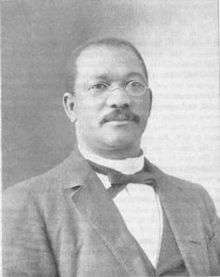William Hooper Councill
William Hooper Councill (July 12, 1848 – 1909) was a former slave and the first president of Huntsville Normal School, which is today Alabama Agricultural and Mechanical University in Normal, Alabama.[1]

He was born a slave in Fayetteville, North Carolina, on July 12, 1848 to William and Mary Jane Councill.[2] His father escaped to Canada in 1854 and made several unsuccessful attempts to free his family.[3] The young William Hooper Councill was taken to Huntsville, Alabama by slave traders in 1857. He and his mother and brothers were sold as slaves from the auction block at Green Bottom Inn to Judge David Campbell Humphreys. At this auction he saw two of his brothers sold in 1857, and never heard from them again.[4]
During the American Civil War, he and his remaining brothers were taken into rural areas to keep them from the Union Army, but before the end of the war they escaped to Union lines. They attended on a part-time basis the Freedmen's Bureau school opened by northerners in Stevenson, Alabama in 1865, where Councill remained until 1867, when he began teaching. He was the first person to teach a school for black students outside of a city in northern Alabama – a position which caused frequent trouble with the Ku Klux Klan.[3] Councill helped start the Lincoln School, four miles west of Huntsville, in 1868, which had 36 students by 1870.[2]
During Reconstruction after the American Civil War, he held minor political positions in Alabama, serving as assistant enrollment clerk in the Alabama legislature in 1872 and 1874.[2] He was a secretary of the Colored National Civil Rights Convention in Washington, DC in 1873.[3] He taught for a time at Morris Brown College in Atlanta, Georgia and edited a newspaper, the Negro Watchman in 1874[3] in Huntsville. Councill used his connections in the Democratic Party and state legislature to gain approval for his plan for the State Normal School for Negroes in 1875, becoming its principal and, later, president.[1][2] He was appointed notary public by Governor Rufus W. Cobb in 1882. In 1883, he was admitted to practice before the Supreme Court of Alabama.[3]
In 1884 he married Maria H. Wheeden from Huntsville.[3]
As a contemporary of Booker T. Washington, he and Washington (who performed research at Tuskeegee Institute) often competed for favors and funds from the Alabama Legislature and northern philanthropists.[5]
In 1887 Councill attracted wide attention when he complained to the Interstate Commerce Commission of harsh treatment on the Alabama railroad. That action later prompted his superiors to relieve him of his duties as president of AAMU for one year. That experience may have helped alter his position on the proper role for a Black man to play in the South during that era, because afterwards, he advocated accommodation and acceptance of his "unctuous sycophancy", which prompted Washington to characterize him as "simply toadying to White people."[6] He served at AAMU until 1909, although Solomon T. Clanton served as acting president in 1903 when Council was ill.[7] Under his leadership, AAMU was second only to Tuskegee Institute in size among Alabama Negro industrial schools.
Councill compiled the illustrated cultural history book Lamp of Wisdom; or Race History Illustrated in 1898. It was published by J. T. Haley of Nashville.[8][9]
Legacy

The first high school for blacks in Huntsville was named for him when it opened in 1867. William Hooper Councill High School closed after schools were integrated in the 1960s.[10] The high school building is listed on the Alabama Register of Landmarks and Heritage.
Notes
- D. W. Culp, ed., Twentieth Century Negro Literature, Or, A Cyclopedia of Thought on the Vital Topics Relating to the American Negro Naperville, Illinois: J. L. Nichols & Co., 1902, OCLC 837541, p. 325. Released as an ebook on July 6, 2006 EBook #18772 by The Project Gutenberg
- "VII. Narrative", Alabama Agricultural and Mechanic University Historic District (PDF), National Register Of Historic Places Continuation Sheet, National Park Service, United States Department of the Interior
- Simmons, William J., and Henry McNeal Turner. Men of Mark: Eminent, Progressive and Rising. GM Rewell & Company, 1887. p390-393
- Simpson, Dennis William (1993). The Descendants of Doctor William Simpson. Chelsea, Michigan: Bookcrafters. pp. 47–48. OCLC 30978656.
- Sherer, Robert G. (1930). "William Burns Paterson: "Pioneer as well as Apostle of Negro Education in Alabama". The Alabama historical quarterly. 36 (2: summer 1974): 143–147. Retrieved 10 July 2017.
- August Meier, Negro Thought in America, 1880–1915: Racial Ideologies in the Age of Booker T. Washington, Ann Arbor: University of Michigan, 1963, repr. 1988, ISBN 9780472642304, pp. 77, 110.
- [No Headline] American Baptist (Louisville, Kentucky) December 18, 1903, page 2, accessed October 7, 2016 at https://www.newspapers.com/clip/6930752/no_headline_american_baptist/
- Association, Southern History (April 30, 1899). "Publications of the Southern History Association". Southern History Association – via Google Books.
- Alderman, Edwin Anderson; Harris, Joel Chandler; Kent, Charles W.; Smith, Charles Alphonso; Knight, Lucian Lamar (April 30, 1910). "Library of Southern Literature". Martin and Hoyt Company – via Google Books.
- William Hooper Councill High School Site 1892 – 1966, Historic Markers, City of Huntsville, 2010.